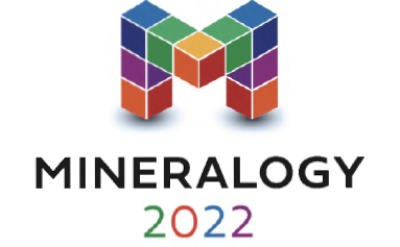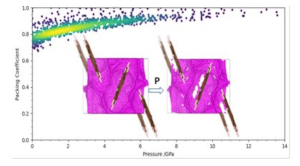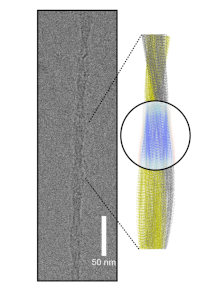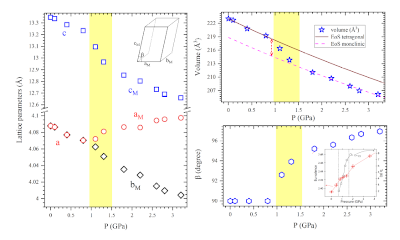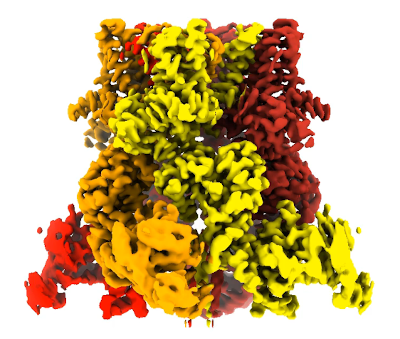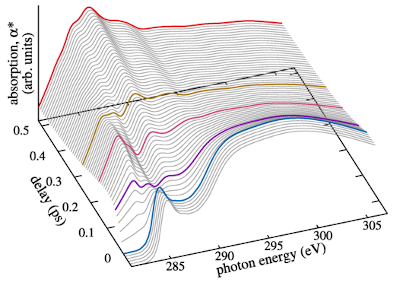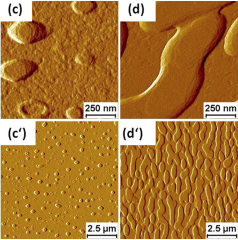In the last decades the extracellular matrix (ECM) has aroused growing interest thanks to its pivotal bio-physical interaction with cells, modelling the structure and function of tissues in relation to physiologic and pathologic stimuli. It is a complex fibrous network made by different components, but the main fibril-forming protein is type I collagen. Thanks to its tissue-specific morphology, its hierarchical structure and the functional domains, it supplies bio-physical support to cells attachment, tissue growth and re-modeling. From the molecular order, up to supramolecular scale, type I collagen is organized in triple helices assembled in fibrils and fibers, in accordance with a liquid crystalline arrangement at nanoscale, a quasi hexagonal packing observed in corneal tissue.[1] In order to study collagen arrangement and to deeply understand the role of its alteration at both atomic and nanoscale in pathology, we combined scanning small (SAXS) and wide angle (WAXS) X ray scattering microscopies, inspecting the structural features in the tissue over an extended area. For instance, mapping abdominal and popliteal aortic aneurysms biopsies by scanning X-ray microscopy led to the detection and co-localization of the nanometric structure of type I collagen, myofilament and elastin, organic components of the tissues. It were also identified pathological micro calcifications, whose crystalline phases have been identified.[2] Multiscale scanning microcopies were also employed for the structural characterization of intra- and inter-molecular features of type I collagen in diabetes minimal models for the study of the effect of glycation. In particular X-ray scattering (SAXS/WAXS) analyses conducted on decellularized bovine pericardia biotissues, soaked with different sugars (D-glucose, D-galactose, D-ribose) at increasing concentrations (0, 2.5, 5, 10, 20 and 40 mg/ml), and incubated at 37°C for 3, 14, 30 and 90 days, allowed to identify the sites of glycation and speed of glycation due to glucose/galactose and ribose.[3,4,5] Moreover the study of type I collagen by X-ray diffraction techniques have also demonstrated to be a useful tool in regenerative medicine. Indeed, its biocompatibility, activity and degradability, made collagen attractive as biomaterial for implantable medical devices. It was extracted from different collagen-rich tissues of distinct animal species by chemical and/or enzymatic processes and each biomaterial fabrication steps could modify the physiologic sub and supramolecular features of the protein, leading to different biomaterials. WAXS and SAXS techniques have revealed how manufacturing protocols deeply affect the structural characteristic of the biomaterial itself, and therefore its function, becoming fundamental tools to screen the suitable protocols, according to the tissue to regenerate. [6,7,8]
[1] Sibillano, T., De Caro, L., Scattarella, F., Scarcelli, G., Siliqi, D., Altamura, D., Liebi, M., Ladisa, M., Bunk, O., & Giannini, C., Journal of applied crystallography, 2016, 49 Pt 4, 1231-1239 .
[2] Giannini, C., Ladisa, M., Lutz-Bueno, V., Terzi, A., Ramella, M., Fusaro, L., Altamura, D., Siliqi, D., Sibillano, T., Diaz, A., Boccafoschi, F. & Bunk, O., IUCrJ, 2019, 6, 267-276.
[3] Giannini C, Terzi A, Fusaro L, Sibillano T, Diaz A, Ramella M, Lutz-Bueno V, Boccafoschi F, Bunk O. J Biophotonics, 2019, 12(10)
[4] Giannini, C., De Caro, L., Terzi, A., Fusaro, L., Altamura, D., Diaz, A., Lassandro, R., Boccafoschi, F. & Bunk, O., 2021, IUCrJ 8, 621-632
[5] De Caro, L., Terzi, A., Fusaro, L., Altamura, D., Boccafoschi, F., Bunk, O. & Giannini, C., IUCrJ, 2021, 8, 1024-1034
[6] A. Terzi, E. Storelli, S. Bettini, T. Sibillano, D. Altamura, L. Salvatore, M. Madaghiele, A. Romano, D. Siliqi, M. Ladisa, L. De Caro, A. Quattrini, L. Valli, A. Sannino, C., Giannini, Sci Rep., 2018, 8, 1, 1429
[7] A. Terzi, N. Gallo, S. Bettini, T. Sibillan o, D. Altamura, L. Campa, M.L. Natali, L. Salvatore, M. Madaghiele, L. De Caro, L. Valli, A. Sannino, C. Giannini, Front Bioeng Biotechnol., 2019, 7, 203
[8] D. Altamura, R. Lassandro, F.A. Vittoria, L. De Caro, D. Siliqi, M. Ladisa, C. Giannini, J.Appl. Cryst., 2012, 45, 869–87

